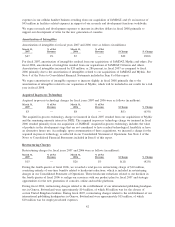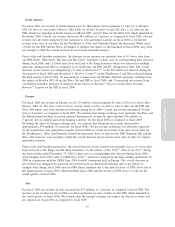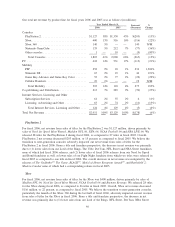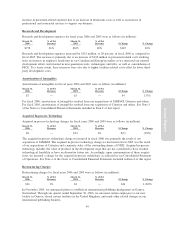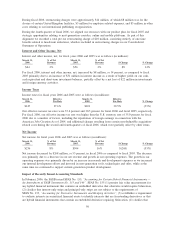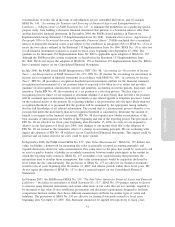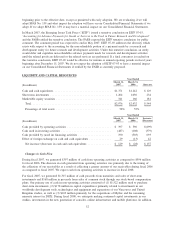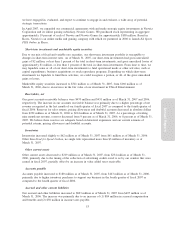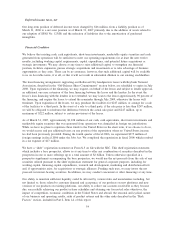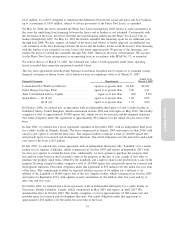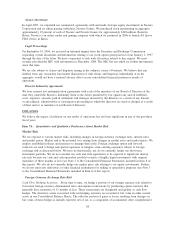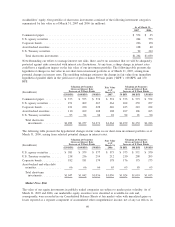Electronic Arts 2007 Annual Report Download - page 125
Download and view the complete annual report
Please find page 125 of the 2007 Electronic Arts annual report below. You can navigate through the pages in the report by either clicking on the pages listed below, or by using the keyword search tool below to find specific information within the annual report.
concentrations of credit risk in the form of subordination are not embedded derivatives, and (5) amends
SFAS No. 140, “Accounting for Transfers and Servicing of Financial Assets and Extinguishments of
Liabilities — A Replacement of FASB Statement No. 125” to eliminate the prohibition on a qualifying special-
purpose entity from holding a derivative financial instrument that pertains to a beneficial interest other than
another derivative financial instrument. In December 2006, the FASB cleared guidance in Derivatives
Implementation Group Statement 133 Implementation Issue No. B40, “Embedded Derivatives: Application of
Paragraph 13(b) to Securitized Interests in Prepayable Financial Assets”. FASB concluded that a securitized
interest in prepayable financial assets is not subject to the conditions in paragraph 13(b) of SFAS No. 133 if it
meets the two criteria outlined in the Statement 133 Implementation Issue No. B40. SFAS No. 155 is effective
for all financial instruments acquired or issued for fiscal years beginning after September 15, 2006. The
guidance in the Statement 133 Implementation Issue No. B40 is applicable upon adoption of SFAS No. 155,
although the FASB provides certain exceptions as described in the Statement 133 Implementation Issue
No. B40. We do not expect the adoption of SFAS No. 155 or Statement 133 Implementation Issue No. B40 to
have a material impact on our Consolidated Financial Statements.
In July 2006, the FASB issued FASB Interpretation (“FIN”) No. 48, “Accounting for Uncertainty in Income
Taxes — An Interpretation of FASB Statement No. 109”. FIN No. 48 clarifies the accounting for uncertainty in
income taxes recognized in financial statements in accordance with SFAS No. 109, “Accounting for Income
Taxes”. FIN No. 48 prescribes a recognition threshold and measurement attribute for the financial statement
recognition and measurement of a tax position taken or expected to be taken in a tax return and provides
guidance on derecognition, classification, interest and penalties, accounting in interim periods, disclosure, and
transition. Under FIN No. 48, the evaluation of a tax position is a two-step process. The first step is a
recognition process where we are required to determine whether it is more likely than not that a tax position
will be sustained upon examination, including resolution of any related appeals or litigation processes, based
on the technical merits of the position. In evaluating whether a tax position has met the more-likely-than-not
recognition threshold, it is presumed that the position will be examined by the appropriate taxing authority
that has full knowledge of all relevant information. The second step is a measurement process whereby a tax
position that meets the more-likely-than-not recognition threshold is calculated to determine the amount of
benefit to recognize in the financial statements. FIN No. 48 also requires new tabular reconciliation of the
total amounts of unrecognized tax benefits at the beginning and end of the reporting period. The provisions of
FIN No. 48 are effective for fiscal years beginning after December 15, 2006. As such, we are required to
adopt it in our first quarter of fiscal year 2008. Any changes to our income taxes due to the adoption of
FIN No. 48 are treated as the cumulative effect of a change in accounting principle. We are evaluating what
impact the adoption of FIN No. 48 will have on our Consolidated Financial Statements. This impact could be
material and our future effective tax rates could be more volatile.
In September 2006, the FASB issued SFAS No. 157, “Fair Value Measurements”. SFAS No. 157 defines fair
value, establishes a framework for measuring fair value in generally accepted accounting principles and
expands disclosures about fair value measurements. Fair value refers to the price that would be received to sell
an asset or paid to transfer a liability in an orderly transaction between market participants in the market in
which the reporting entity transacts. SFAS No. 157 establishes a fair value hierarchy that prioritizes the
information used to develop those assumptions. Fair value measurements would be separately disclosed by
level within the fair value hierarchy. The provisions of SFAS No. 157 are effective for financial statements
issued for fiscal years beginning after November 15, 2007, and interim periods within those fiscal years. We
do not expect the adoption of SFAS No. 157 to have a material impact on our Consolidated Financial
Statements.
In February 2007, the FASB issued SFAS No. 159, “The Fair Value Option for Financial Assets and Financial
Liabilities — Including an amendment of FASB Statement No. 115”. SFAS No. 159 permits entities to choose
to measure many financial instruments and certain other items at fair value that are not currently required to
be measured at fair value. It also establishes presentation and disclosure requirements designed to facilitate
comparisons between entities that choose different measurement attributes for similar types of assets and
liabilities. The provisions of SFAS No. 159 are effective for financial statements issued for fiscal years
beginning after November 15, 2007. This Statement should not be applied retrospectively to fiscal years
Annual Report
51



